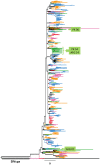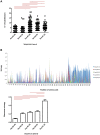HIV-1 subtype A gag variability and epitope evolution
- PMID: 24892852
- PMCID: PMC4043486
- DOI: 10.1371/journal.pone.0093415
HIV-1 subtype A gag variability and epitope evolution
Abstract
Objective: The aim of this study was to examine the course of time-dependent evolution of HIV-1 subtype A on a global level, especially with respect to the dynamics of immunogenic HIV gag epitopes.
Methods: We used a total of 1,893 HIV-1 subtype A gag sequences representing a timeline from 1985 through 2010, and 19 different countries in Africa, Europe and Asia. The phylogenetic relationship of subtype A gag and its epidemic dynamics was analysed through a Maximum Likelihood tree and Bayesian Skyline plot, genomic variability was measured in terms of G → A substitutions and Shannon entropy, and the time-dependent evolution of HIV subtype A gag epitopes was examined. Finally, to confirm observations on globally reported HIV subtype A sequences, we analysed the gag epitope data from our Kenyan, Pakistani, and Afghan cohorts, where both cohort-specific gene epitope variability and HLA restriction profiles of gag epitopes were examined.
Results: The most recent common ancestor of the HIV subtype A epidemic was estimated to be 1956 ± 1. A period of exponential growth began about 1980 and lasted for approximately 7 years, stabilized for 15 years, declined for 2-3 years, then stabilized again from about 2004. During the course of evolution, a gradual increase in genomic variability was observed that peaked in 2005-2010. We observed that the number of point mutations and novel epitopes in gag also peaked concurrently during 2005-2010.
Conclusion: It appears that as the HIV subtype A epidemic spread globally, changing population immunogenetic pressures may have played a role in steering immune-evolution of this subtype in new directions. This trend is apparent in the genomic variability and epitope diversity of HIV-1 subtype A gag sequences.
Conflict of interest statement
Figures





Similar articles
-
Phylogenetic Characterization of HIV-1 Sub-Subtype A1 in Karachi, Pakistan.Viruses. 2022 Oct 20;14(10):2307. doi: 10.3390/v14102307. Viruses. 2022. PMID: 36298862 Free PMC article.
-
Analysis of temporal changes in HIV-1 CRF01_AE gag genetic variability and CD8 T-cell epitope evolution.PLoS One. 2022 May 10;17(5):e0267130. doi: 10.1371/journal.pone.0267130. eCollection 2022. PLoS One. 2022. PMID: 35536783 Free PMC article.
-
CTL epitope distribution patterns in the Gag and Nef proteins of HIV-1 from subtype A infected subjects in Kenya: use of multiple peptide sets increases the detectable breadth of the CTL response.BMC Immunol. 2006 Apr 18;7:8. doi: 10.1186/1471-2172-7-8. BMC Immunol. 2006. PMID: 16620386 Free PMC article.
-
Novel and promiscuous CTL epitopes in conserved regions of Gag targeted by individuals with early subtype C HIV type 1 infection from southern Africa.J Immunol. 2004 Oct 1;173(7):4607-17. doi: 10.4049/jimmunol.173.7.4607. J Immunol. 2004. PMID: 15383595
-
Population-specific evolution of HIV Gag epitopes in genetically diverged patients.Infect Genet Evol. 2013 Jun;16:78-86. doi: 10.1016/j.meegid.2013.02.003. Epub 2013 Feb 10. Infect Genet Evol. 2013. PMID: 23403357
Cited by
-
Origin and evolution of HIV-1 subtype A6.PLoS One. 2021 Dec 13;16(12):e0260604. doi: 10.1371/journal.pone.0260604. eCollection 2021. PLoS One. 2021. PMID: 34898626 Free PMC article.
-
Prevalence of Transmitted Drug Resistance Mutations in HIV-1-Infected Drug-Naive Patients from Urban and Suburban Regions of Kenya.AIDS Res Hum Retroviruses. 2016 Mar;32(3):220-5. doi: 10.1089/aid.2015.0026. Epub 2015 Sep 24. AIDS Res Hum Retroviruses. 2016. PMID: 26401720 Free PMC article.
-
Phylogenetic Characterization of HIV-1 Sub-Subtype A1 in Karachi, Pakistan.Viruses. 2022 Oct 20;14(10):2307. doi: 10.3390/v14102307. Viruses. 2022. PMID: 36298862 Free PMC article.
-
Unravelling the complicated evolutionary and dissemination history of HIV-1M subtype A lineages.Virus Evol. 2018 Feb 19;4(1):vey003. doi: 10.1093/ve/vey003. eCollection 2018 Jan. Virus Evol. 2018. PMID: 29484203 Free PMC article.
-
Molecular epidemiology of HIV-1 subtype A in former Soviet Union countries.PLoS One. 2018 Feb 1;13(2):e0191891. doi: 10.1371/journal.pone.0191891. eCollection 2018. PLoS One. 2018. PMID: 29389951 Free PMC article.
References
-
- Moore CB, John M, James IR, Christiansen FT, Witt CS, et al. (2002) Evidence of HIV-1 adaptation to HLA-restricted immune responses at a population level. Science 296: 1439–1443. - PubMed
-
- Ansari AS, Khanani MR, Abidi SH, Shah F, Shahid A, et al. (2011) Patterns of HIV infection among native and refugee Afghans. AIDS 25: 1427–1430. - PubMed
Publication types
MeSH terms
Substances
LinkOut - more resources
Full Text Sources
Other Literature Sources
Research Materials

